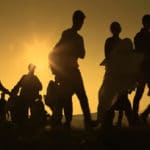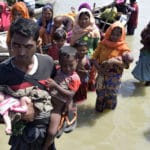Perilous Passage: The Humanitarian Crisis in the Darien Gap

It is the only way to reach the United States overland from South America. However, those who venture through the Darien Gap encounter a route characterized by unpredictability and danger. The path cuts through the untouched and densely forested rainforest but remains more popular than ever among migrants, despite the swiftly flowing rivers, steep and slippery mountain trails, and treacherous rocks.
The Darien Gap lies between Panama and Colombia, connecting two continents. There are no roads or hiking trails, and the journey through the wilderness can last up to eleven days or even longer. Yet, according to Panamanian statistics for the first seven months of this year, nearly a quarter of a million migrants chose to undertake the trek through the wilderness. That number already surpasses the total for the entire year of 2022, despite various international efforts to discourage the migration route. The United Nations expects a total of 400,000 migrants to attempt crossing the gap this year.
Mostly South American migrants take the jungle route, hoping to have a chance at asylum status in the United States upon arrival. According to the BBC, the majority of migrants attempting to traverse the Darien Gap come from Venezuela, Haiti, and Ecuador.
The allure of a better life and the promise of potential asylum motivate these migrants to embark on this perilous journey through the dense and untamed rainforest. Despite the dangers and the obstacles, the flow of migrants shows no sign of abating, making it a complex and pressing challenge for both the countries involved and the international community.
The Red Cross characterizes the current situation as a “major humanitarian crisis. “However, the increase in numbers is not new: two years ago, Unicef reported a record number of children traveling through the Darien Gap. At that time, it represented a tripling compared to previous years. In 2023, many children are still crossing the area, with one in five migrants being minors.
The rainforest also attracts criminal gangs that rob, extort, and rape migrants.
“Deep in the jungle, theft, rape, and human trafficking are just as dangerous as wild animals, insects, and the severe lack of safe drinking water,” says Unicef director Jean Gough.
“Week after week, more children die, lose their parents, or get separated from their family members during this perilous journey.”
According to Unicef, in 2021, more than 150 children arrived in Panama without their parents.
Doctors Without Borders (MSF) opened special reception centers in the first Panamanian village where migrants arrive during the summer of that year. In the camps, doctors treat trauma wounds, skin conditions, and foot injuries, often caused by the slippery and treacherous mud paths. MSF also provides mental health care for migrants who witnessed others die before their eyes.
The jungle area holds not only human dangers but also harbors jaguars, poisonous spiders, frogs, and snakes. Last year, the International Organization for Migration recorded 36 deaths during attempted crossings. Drowning is the most common cause of death. The actual number is likely higher since many bodies may never be found in the jungle.
The situation in the Darien Gap remains dire and complex, with vulnerable migrants, including children, facing both natural and human threats. Urgent action and cooperation are needed to address this humanitarian crisis and find safe and sustainable solutions for those embarking on this perilous journey.










